Clearing the air over low-VOC coatings
by Catherine Howlett | November 1, 2012 12:16 pm
 [1]
[1]With growing emphasis on environmental regulatory compliance, specifiers are discovering less is more when it comes to meeting requirements on volatile organic compounds (VOCs). Over the past decade, VOC content in waterborne and high-solids coatings has dramatically decreased while performance and durability of the solvent-based coatings they replace has remained.
According to the American Coatings Association (ACA), these coatings meet regulatory and consumer requirements, have low VOCs, exhibit low-to-no odor, and can be applied over an expanded temperature and humidity range. They also have properties that are equal to or better than their solvent-based counterparts. (See ACA’s “Technological Development[2]” brochure.)
Typically, VOC emissions occur during the application and curing process when solvents contained in coatings evaporate, along with non-reactive diluents. These VOC emissions contribute to ground-level ozone[3] (O3), the primary component of smog.
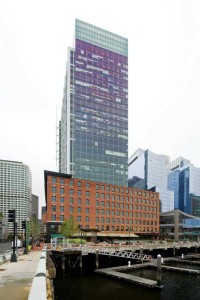 [4]
[4]Photo © Brett Drury, ASMP, Architectural Photograph. Photo courtesy Tnemec
Under rules published by the U.S. Environmental Protection Agency (EPA) and Environment Canada, a limit is placed on the VOC content allowed in architectural and industrial maintenance (AIM) coatings based on grams per liter (g/L). In the United States, EPA is required by the Clean Air Act to enforce national air quality standards for not only ground-level ozone, but also:
- particulate matter (PM);
- nitrogen oxides (NO2);
- carbon monoxide (CO);
- sulfur dioxide (SO2); and
- lead (Pb).
Parts of the country failing to meet these standards are classified as “non-attainment areas.” They are required to develop state implementation plans (SIPs) for attaining EPA[5]’s national ambient air quality standard (NAAQS), which is 0.075 parts per million (ppm) for ground-level ozone[3] with an eight-hour averaging time.
EPA also regulates hazardous air pollutants (HAPs) at coating manufacturing facilities, as well as original equipment manufacturer (OEM) and fabricator plants.
High in performance, low in VOCs
In recent years, changes in coating formulations[6] have significantly reduced VOC emission levels. In many cases, the technology found in low-VOC AIM coatings allows them to outperform older, solvent-based formulations on architectural and industrial applications where protection and finishing of steel and concrete is required.
Coatings manufacturers have developed three primary ways to lower VOCs:
- advancement of water-based technologies;
- introduction of products with higher solids and lower solvent contents; and
- use of exempt solvents in coating formulations.
Some waterborne epoxy coatings have demonstrated all the high-performance characteristics of traditional epoxies containing xylene or methyl ethyl ketone (MEK). In accelerated testing using ASTM B117, Standard Practice for Operating Salt-spray (Fog) Apparatus, a single coat of water-based epoxy revealed no more than 4.8 mm (3⁄16 in.) of rust creepage at the scribe after 6200 hours of exposure. Using the same testing method, two coats of a traditional solvent-based epoxy coating revealed no more than 1.6 mm (1⁄16 in.), with one percent rusting on the plane after 6700 hours of exposure.
 [7]
[7]Images courtesy Tnemec Company
Water-based epoxy technologies have zero HAP per gallon and are low-VOC, which makes them suited for steel fabricators and OEMs. The coating technology has been successfully applied on:
- the interior and exterior of steel and concrete tanks;
- masonry;
- floors;
- both the structural and miscellaneous steel components; and
- interior wall applications.
New-generation low-VOC hybrid polyurethanes have demonstrated superior durability and toughness while outperforming standard aliphatic polyurethanes in architectural and industrial exposures (Figure 1). The high-solids, polyurethane technology resists ultraviolet (UV) light degradation and weathering, while retaining color and gloss; they are often used on industrial equipment, tanks, and structural steel. With less than 100-g/L VOC content, these formulations can be applied using brushes, rollers, or spray equipment.
Enhancing color and gloss retention in both interior and exterior exposures can still be achieved with water-based, low-VOC acrylic technology (Figure 2). With VOC content of less than 100 g/L, the single component coating has a fast curing time, which is important in coastal exposures subject to high humidity and salt fog.
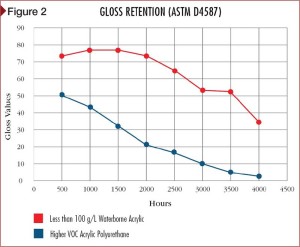
Low-VOC fluoropolymer technology is also being specified for exterior exposures requiring an ultra-durable finish, with color and gloss retention. With less than 100-g/L VOC content, the high-solids fluoropolymer resin is more stable than acrylic or conventional polyurethane resin and is more resistant to the damaging effects of UV light. Available in gloss, semi-gloss, satin, and metallic finishes, low-VOC fluoropolymer formulations offer the same performance of other fluoropolymer coatings containing much higher VOC levels.
Regulatory drivers
The growing list of low-VOC products enables specifiers to meet the challenge posed by myriad national, regional, state, and local rules—each with their own different coating categories and VOC content limitations. As shown in Figure 3, the regulatory rule-makers include:
- EPA;
- Ozone Transport Commission (OTC);
- Lake Michigan Air Directors Consortium (LADCO);
- California Air Resources Board (CARB); and
- South Coast Air Quality Management District (SCAQMD).
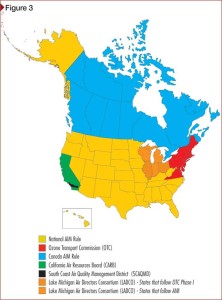
Covering most of the country, EPA’s National Volatile Organic Compound Emission Standards for Architectural Coatings (also known as the AIM Rule) creates minimum requirements for VOC[8] content limits for 61 coating categories and sub-categories, while allowing individual states flexibility to adopt stricter policies within their jurisdictions. The national AIM Rule employs 450 g/L as the limit for industrial maintenance coatings.
OTC is more stringent than the AIM Rule when it comes to VOC restrictions on high-performance coatings. For example, the Ozone Transport Commission AIM Model Rule[9] uses 340 g/L as the VOC content limit for industrial maintenance coatings.
California has had a major influence on the development of VOC coatings regulations since CARB was established in 1967. As part of the California Environmental Protection Agency, CARB[10]’s model rule limits VOC content in industrial maintenance coatings to 250 g/L; this is enforced as required by the 2010 California Green Building Standards Code (CALGreen).
The most restrictive VOC coatings regulation is SCAQMD[11]’s Rule 1113, which applies to the seven southern counties in and around the Los Angeles metropolitan area. VOC limits of 50 g/L for coating classifications such as “flat” and “non-flat” are not uncommon under Rule 1113. Many of the high-performance coatings sold in these counties are specifically formulated to meet SCAQMD[12]’s 100-g/L limit for its industrial maintenance category.
Going ‘green’
Demand for low-VOC coatings that offer high performance is also being driven by private standard-setting organizations such as the U.S. Green Building Council (USGBC), Green Seal, and American National Standards Institute (ANSI).
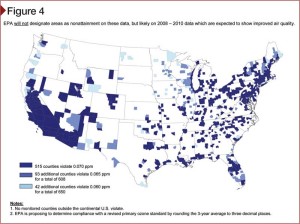
Jurisdictions across the United States are adopting sustainable building programs that incorporate USGBC’s Leadership in Energy and Environmental Design (LEED) rating system, which is widely regarded as the national standard in green building. Using low-VOC coatings that ensure good indoor air quality (IAQ) is one way buildings can earn points toward LEED certification.
For example, Boston’s municipal zoning code requires that all large-scale projects meet LEED certification standards.(Other cities requiring LEED certification range from Arlington, Massachusetts, and Atlanta, Georgia, to New York City and Scottsdale, Arizona. In California, all new state buildings and renovation projects are required to attain certification. [Similar requirements exist in many of the state’s cities.] On a national level, U.S. General Services Administration [GSA] had adopted the LEED green building program to achieve the sustainability objective for public buildings, but is currently considering other green building certification programs.) This mandate has resulted in a new generation of sustainable developments, including the new 31-story Atlantic Wharf mixed-use project located on the Fort Point waterfront. Designed to use 33 percent less energy and 69 percent less domestic water than comparable downtown office towers, Atlantic Wharf[13] features interior and exterior coatings that assisted the developer in achieving LEED Platinum certification. The coatings included a high-solids fluoropolymer finish, which was selected to achieve the performance requirements of gloss and color retention and resistance to UV and abrasion.
A similar high-solids fluoropolymer coating system was used for a LEED Gold project—the award-winning structural steel ‘tiara’ above the 41-story Great American Tower in Cincinnati, Ohio. Weighing more than 400 tons, the iconic tiara design was a winner of the prestigious 2012 Innovative Design in Engineering and Architecture with Structural Steel awards program presented by the American Institute of Steel Construction (AISC[14]).
The new generation of low-VOC coating technology is also being specified for an increasing number of industrial applications, including bridges, potable water tanks, and even public artwork.
Future developments
ACA recently reported SCAQMD[15] is considering a 25-g/L VOC limit for selected coatings. Earlier this year, the California Supreme Court upheld SCAQMD’s authority to enact stiffer air-quality rules[16] on AIM coatings “based on technologies that do not currently exist but are reasonably anticipated to exist by the compliance deadline.”
EPA has also proposed lowering the ozone standard[17]. Adoption of a new standard could leave large areas of the country in non-attainment for ozone air pollution and likely require more local or statewide VOC regulations (Figure 4). EPA[18] is expected to propose its new revisions next fall and finalize the standard in 2014.
This spring, USGBC is scheduled to hold its ballot on LEED v4, which focuses on increasing technical stringency from past versions and developing new requirements for project types such as data centers, warehouse distribution centers, hotels and motels, existing schools, and retail buildings. As VOC limits are ratcheted down, specifiers and engineers will be challenged with finding products that comply with these credit requirements, while still providing the performance needed for the intended use of the coating.
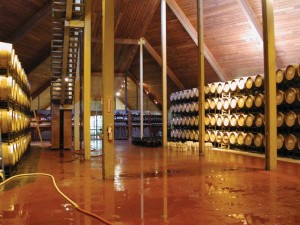
For technical information on low-VOC coatings such as volume solids, common use, VOC levels, curing times, and theoretical coverage, specifiers can refer to the manufacturer’s product data sheets and marketing literature. The manufacturer’s representatives for these products need to be consulted during the specification process and kept informed of project details and performance requirements to make VOC-compliant coating recommendations.
Specifiers are advised low-VOC coatings that are waterborne or contain high solids are often less forgiving of surface contamination and moisture than traditional solvent-based coatings. Knowledgeable coating consultants and technical service representatives can be invaluable sources of information on low-VOC technologies, which often require closer attention during surface preparation, mixing, and application. Manufacturer representatives can offer helpful advice on the use of thinners and other field-applied components, which can elevate the coating’s VOC content and make it noncompliant with local regulatory standards.
Given all the variables and nuances that can affect the selection and use of low-VOC technologies, specifiers should always require coating representatives or manufacturers to document, in writing, their compliant recommendations for coatings based on their intended use.
Terry Wallace, CSI, CDT, LEED AP, is vice president of sales for Tnemec Company. He has an extensive background in architectural coatings and troubleshooting moisture-intrusion issues involving all types of masonry structures. Wallace is an active member of Construction Specifications Institute (CSI), and a Level III certified coating inspector under NACE International–The Corrosion Society. He has chaired the Society for Protective Coatings’ Fluoropolymer Committee, and is a certified consultant of concrete masonry under the National Concrete Masonry Association (NCMA). Wallace holds a bachelor’s degree in industrial marketing management from California State Polytechnic University. He can be contacted at wallace@tnemec.com[19].
- [Image]: http://www.constructionspecifier.com/wp-content/uploads/2012/11/voc_AtlanticWharf07.jpg
- Technological Development: http://www.paint.org/about-our-industry/technological-development.html
- ground-level ozone: http://www.epa.gov/air/ozonepollution/%20pdfs/20100106present.pdf
- [Image]: http://www.constructionspecifier.com/wp-content/uploads/2012/11/voc_Figure6.jpg
- EPA: http://www.epa.gov/airtrends/2011/report/fullreport.pdf
- coating formulations: http://www.paint.org/find-your-issue/clean-air.html?tmpl=component&print=1
- [Image]: http://www.constructionspecifier.com/wp-content/uploads/2012/11/CS_Nov2012_HR-Fig1.jpg
- VOC: http://www.epa.gov/ttn/atw/183e/aim/aimfact.pdf
- Ozone Transport Commission AIM Model Rule: http://www.ct.gov/dep/lib/dep/air/ozone/ozone_sip_revision/aim.pdf
- CARB: http://www.arb.ca.gov/drdb/drdbltxt.htm
- SCAQMD: http://www.aqmd.gov/prdas/Coatings/table_of_standards.htm
- SCAQMD: http://www.eco-structure.com/low-voc/green-coatings.aspx
- Atlantic Wharf: http://www.atlanticwharfoffice.com/sustainability/introduction
- AISC: http://www.aisc.org/newsdetail.aspx?id=31642
- SCAQMD: http://www.paint.org/news/industry-news/item/964-scaqmd%E2%80%99s-2012-air-quality-management-plan-moving-forward-aca-to-submit-additional-comments-aug-31.html
- air-quality rules: http://www.durabilityanddesign.com/news/fuseaction=view&id=7941&nl_versionid=2132
- ozone standard: http://www.epa.gov/air/ozonepollution/pdfs/20100106present.pdf
- EPA: http://www.epa.gov/glo/pdfs/OzoneMemo9-22-11.pdf
- wallace@tnemec.com: mailto:wallace@tnemec.com
Source URL: https://www.constructionspecifier.com/clearing-the-air-over-low-voc-coatings/